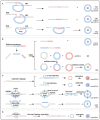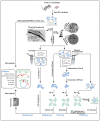Extrachromosomal Circular DNA: Category, Biogenesis, Recognition, and Functions
- PMID: 34568472
- PMCID: PMC8458813
- DOI: 10.3389/fvets.2021.693641
Extrachromosomal Circular DNA: Category, Biogenesis, Recognition, and Functions
Erratum in
-
Corrigendum: Extrachromosomal Circular DNA: Category, Biogenesis, Recognition, and Functions.Front Vet Sci. 2021 Oct 27;8:784611. doi: 10.3389/fvets.2021.784611. eCollection 2021. Front Vet Sci. 2021. PMID: 34778442 Free PMC article.
Abstract
Extrachromosomal circular DNA (eccDNA), existing as double-stranded circular DNA, is derived and free from chromosomes. It is common in eukaryotes but has a strong heterogeneity in count, length, and origin. It has been demonstrated that eccDNA could function in telomere and rDNA maintenance, aging, drug resistance, tumorigenesis, and phenotypic variations of plants and animals. Here we review the current knowledge about eccDNA in category, biogenesis, recognition, and functions. We also provide perspectives on the potential implications of eccDNA in life science.
Keywords: eccDNA; livestock; microDNA; molecular marker; tumor.
Copyright © 2021 Cao, Wang, Ge, Zhang, Huang and Sun.
Conflict of interest statement
The authors declare that the research was conducted in the absence of any commercial or financial relationships that could be construed as a potential conflict of interest.
Figures




Similar articles
-
Extrachromosomal Circular DNA (eccDNA): From Chaos to Function.Front Cell Dev Biol. 2022 Jan 6;9:792555. doi: 10.3389/fcell.2021.792555. eCollection 2021. Front Cell Dev Biol. 2022. PMID: 35083218 Free PMC article. Review.
-
Classification of extrachromosomal circular DNA with a focus on the role of extrachromosomal DNA (ecDNA) in tumor heterogeneity and progression.Biochim Biophys Acta Rev Cancer. 2020 Aug;1874(1):188392. doi: 10.1016/j.bbcan.2020.188392. Epub 2020 Jul 28. Biochim Biophys Acta Rev Cancer. 2020. PMID: 32735964 Review.
-
Corrigendum: Extrachromosomal Circular DNA: Category, Biogenesis, Recognition, and Functions.Front Vet Sci. 2021 Oct 27;8:784611. doi: 10.3389/fvets.2021.784611. eCollection 2021. Front Vet Sci. 2021. PMID: 34778442 Free PMC article.
-
Extrachromosomal circular DNA: a new potential role in cancer progression.J Transl Med. 2021 Jun 10;19(1):257. doi: 10.1186/s12967-021-02927-x. J Transl Med. 2021. PMID: 34112178 Free PMC article. Review.
-
Extrachromosomal circular DNA in cancer: history, current knowledge, and methods.Trends Genet. 2022 Jul;38(7):766-781. doi: 10.1016/j.tig.2022.02.007. Epub 2022 Mar 8. Trends Genet. 2022. PMID: 35277298 Review.
Cited by
-
Extrachromosomal circular DNA: biogenesis, structure, functions and diseases.Signal Transduct Target Ther. 2022 Oct 2;7(1):342. doi: 10.1038/s41392-022-01176-8. Signal Transduct Target Ther. 2022. PMID: 36184613 Free PMC article. Review.
-
Insight on ecDNA-mediated tumorigenesis and drug resistance.Heliyon. 2024 Mar 11;10(6):e27733. doi: 10.1016/j.heliyon.2024.e27733. eCollection 2024 Mar 30. Heliyon. 2024. PMID: 38545177 Free PMC article. Review.
-
Sequence characterization of eccDNA content in glyphosate sensitive and resistant Palmer amaranth from geographically distant populations.PLoS One. 2022 Sep 14;17(9):e0260906. doi: 10.1371/journal.pone.0260906. eCollection 2022. PLoS One. 2022. PMID: 36103503 Free PMC article.
-
EccBase: A high-quality database for exploration and characterization of extrachromosomal circular DNAs in cancer.Comput Struct Biotechnol J. 2023 Apr 14;21:2591-2601. doi: 10.1016/j.csbj.2023.04.012. eCollection 2023. Comput Struct Biotechnol J. 2023. PMID: 37114214 Free PMC article.
-
A review of strategies used to identify transposition events in plant genomes.Front Plant Sci. 2022 Dec 1;13:1080993. doi: 10.3389/fpls.2022.1080993. eCollection 2022. Front Plant Sci. 2022. PMID: 36531345 Free PMC article. Review.
References
Publication types
LinkOut - more resources
Full Text Sources

